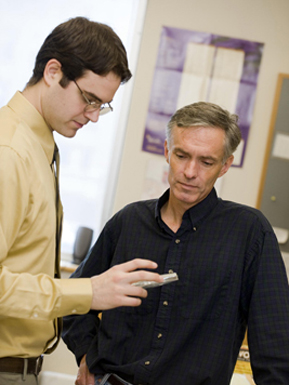Slaying Superbugs
Teaming up to fight drug-resistant bacteria

The superbugs are coming — and not in the realm of Steven Spielberg.
Bacterial infections are outrunning some of the antibiotics designed to kill them. For example, one infamous superbug, methicillin-resistant Staphylococcus aureus, once found only in hospitals, has spread into schools and gyms. It infects about 100,000 people annually and contributes to almost 20,000 deaths in the United States, according to the Centers for Disease Control.
“With the growing emergence of antibiotic resistance, many of our drug therapies are increasingly ineffective,” says Jim Collins, a College of Engineering professor of biomedical engineering and a Howard Hughes Medical Institute investigator.
Bacteria are the ultimate survivors, fighting back guerrilla-style against the army of drugs designed to destroy them. They mutate into drug-resistant superbugs when antibiotics are needlessly prescribed, pumped into livestock on factory farms, or when patients don’t finish the antibiotics they’ve been prescribed.
At the same time, high risk and low profits slow the development of new, more effective bacteria-killing drugs.
So Collins teamed up with Timothy Lu, an M.D./Ph.D. student in the Harvard-MIT Division of Health Sciences and Technology, to give an old weapon for fighting bacterial infections some new ammunition: bacteriophages, viruses that infect and kill bacteria while leaving humans unharmed.
Doctors have used bacteriophages since the early 20th century, but they fell out of favor in the United States after the advent of powerful antibiotics. Now Collins and Lu have genetically modified a bacteriophage so that it zeroes in on a bacteria’s natural DNA repair mechanism, increasing the killing power of antibiotics and hindering the development of superbugs. Their findings appear in the March 2 online issue of the Proceedings of the National Academy of Sciences (PNAS).
“We were trying to find a new solution that would provide a more steady supply of antimicrobial therapies,” says lead author Lu. And in the race against superbugs, speed matters. Manipulating the DNA of a virus takes just a few weeks, rather than the years necessary to develop a new antibiotic.
“The harder part is selecting the right targets for the bacteriophage inside the bacteria,” says Lu. He and Collins chose to engineer their viruses to “overexpress” a protein called lexA3 that knocks out the bacteria’s DNA repair system, which would fend off an antibiotic.
The researchers tested their bacteriophage as an addition to three common antibiotics in test tubes of E. coli, and the combination killed about 30,000 times as many bacteria as the antibiotics alone. The dual therapy was also 1,000 times more effective against drug-resistant bacteria. When Lu and Collins moved on to experiments on mice, 80 percent of E. coli–infected mice treated with both a bacteriophage and an antibiotic survived, compared to 20 percent of mice receiving just antibiotics.
Bacteria will eventually develop resistance to a bacteriophage as well, Collins notes, but “resistance will develop more slowly in a combination therapy.” In a never-ending arms race against superbugs, researchers say, a “library” of bacteriophages engineered to attack bacteria in different ways will always be necessary.
Collins is a scientific advisor for Novophage, a start-up company cofounded by Lu to market genetically engineered bacteriophage therapy for clinical care. The company is very young; its business plan is currently entered in several university competitions, including one sponsored by BU’s Institute for Technology Entrepreneurship and Commercialization.
Chris Berdik can be reached at cberdik@bu.edu.
Comments & Discussion
Boston University moderates comments to facilitate an informed, substantive, civil conversation. Abusive, profane, self-promotional, misleading, incoherent or off-topic comments will be rejected. Moderators are staffed during regular business hours (EST) and can only accept comments written in English. Statistics or facts must include a citation or a link to the citation.